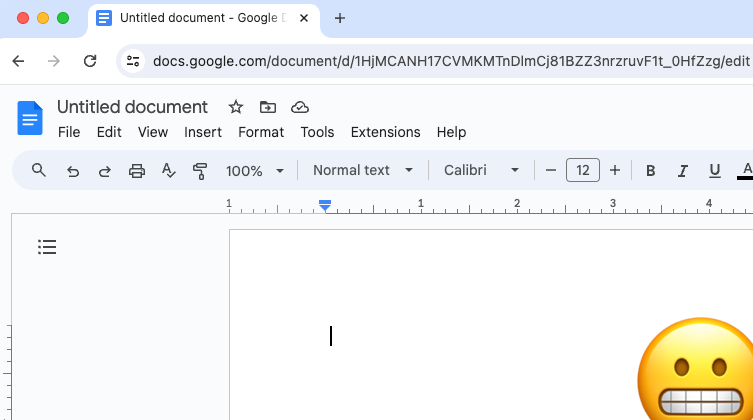
You know that feeling when you're staring at a brand-new Google Doc, and it's completely white except for the blinking cursor in the upper left?
Sometimes this blankness is an open field of possibility, but more often than not, it's stress-inducing.
For individual writers, it can lead to writer’s block. Or it can lead to a desperate banging away at the keyboard in hopes that something good will come out.
I’ve been struggling with the latter response this week as I’ve been working on some personal writing projects. I don’t know exactly what I want to say, yet, but I’m putting a lot of different things onto the page. Maybe some of them will work out, but probably most will just go into the scrapyard.
This can feel good, in a perverse sort of way, if you’re a solo writer and it’s part of your creative process. But if you’re part of a team tasked with producing content, creative angst isn’t going to be a healthy addition to the team dynamic.
That's why a good collaborative writing process is all about avoiding the blank page.
I don’t want anyone on my team to be facing an impassively blinking cursor, not knowing how to get started. At every step of the way, everyone should have something to start with: an outline, an assignment brief, or just an email from a client asking if we could write something for them.
Whatever it is, I put it into a document and use that to start building what I need and planning for what comes next. As we add to this document, questions emerge: What’s the deadline? Will this be published in a magazine or a blog? Where is the key product information we need? We can ask our colleagues or the client, and when we get the answers, we use them to fill out the document with more of the assignment’s requirements.
In this way, your client’s cryptic email notes will evolve into an assignment brief, which will turn into an outline—and if you've got an outline, the writing will be easy — or at least easier.
Whether you’re working alone or in a team, writing is at least five times easier when you're working from a plan.
Collaborating with multiple writers
One of the beauties of having a well-organized process with a plan for each piece of content is that it makes it possible to divide up any part of the work between multiple contributors without things getting chaotic or confused. That applies to the writing just as much as it does to other parts of the content creation process.
In fact, team writing might just be one of the strongest arguments I know for having a good outline.
When you’ve got a good outline, it’s straightforward to assign different sections to different writers, have them work independently, and then stitch everything together when everyone’s contribution is complete, using the outline as a guide. With collaborative editing platforms like Google Docs, each writer can simply drop their contribution directly into the outline as they complete them.
One thing that will definitely help in this situation is giving all the writers a clear deadline to get their pieces in. In collaborative projects like this, it's common to see one or two contributions come in ridiculously early, most of them during the second half of the last possible day, and one or two not appear at all. Then you have to chase down the people who were responsible for those missing pieces. But at least you have a deadline you can wave at them, saying they knew what the assignment was and when it was due. If you’re lucky, the guilt will add just enough extra pressure that they will get their piece done in short order.
Depending on what you’re producing, you might be able to publish each piece as part of a series. For example, you might be doing a series of blog posts on a common theme, putting together a feature package that includes perspectives from a variety of executives, or building a microsite with case studies from various customers.
If this is the case, you’re less dependent on a single hard deadline. Instead, you can take contributions as they come in, edit them, and get them in front of your target audience as soon as the copy is ready. In this situation, the appearance of their colleagues’ work — especially if it’s well-presented — is often enough to motivate the recalcitrant writers to get going and turn their work in. If it’s not, then at least you’ve got contributions from the rest of the team.
When you’re working with multiple writers, you need some way to impose consistency on the collective product. A good outline will help with that. If each section is comparable to the others and has a similar amount of supporting material, the writers should be able to produce finished work that’s fairly well aligned.
Of course, their writing style (and quality) may be all over the place, and that’s where editing comes in. A well-written style guide can help, but at this stage, the benefits of a style guide are overrated.
You can be fairly certain that no one who isn’t a professional writer will ever look at your style guide. Even the pros will probably read it once and then forget to consult it. (I’m reminded of the old newsroom joke: Q: How do you hide a $20 bill from a reporter? A: Slip it into their copy of the AP Stylebook.)
So, for team-based writing, where multiple collaborators are contributing to a single piece, you will need someone to collect all the incoming pieces and impose some order and consistency on them.
That person is the editor—it’s just that their work starts a little bit earlier in the process in this case. Instead of waiting for writers to create a decent first draft, the editor will be in the mix as the draft comes together, providing edits and feedback that are not only aimed at improving the writers’ work, but also ensuring it fits consistently into the overall picture.



